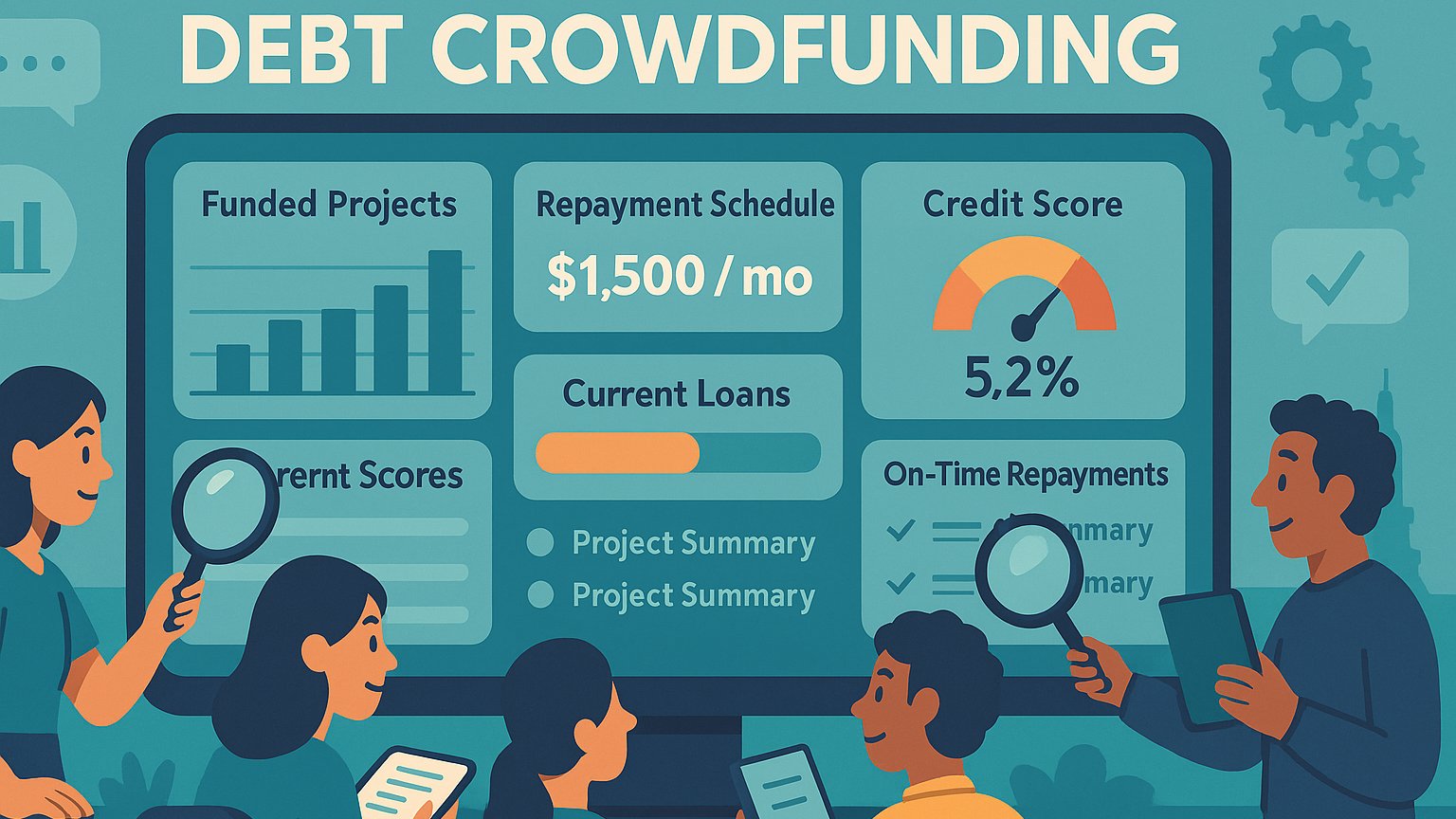Debt-Based Crowdfunding: The Modern Bridge Between Borrowers and Lenders
Debt-based crowdfunding is quietly rewriting the rules of lending and borrowing. While most people think of crowdfunding as a way to launch a product or raise donations, there’s an equally powerful model that revolves around loans. This model, often referred to as peer-to-peer lending or marketplace lending, empowers individuals and businesses to borrow money directly from a group of investors—without stepping foot into a traditional bank.
It’s crowdfunding with a contract. Instead of equity or rewards, backers earn interest, and borrowers gain capital they can repay over time. This shift in financial access is opening doors for entrepreneurs, small businesses, and everyday people who want to sidestep bureaucracy and go straight to the crowd.
In this comprehensive guide, we’ll explore the full scope of debt-based crowdfunding, from how it works for both creators and investors to what platforms are leading the charge. It’s an exciting world where finance meets flexibility, community meets capital, and everyone has a chance to participate.

Investors in Debt Crowdfunding
Debt-based crowdfunding investors are the quiet powerhouses fueling growth for businesses and individuals seeking a new kind of opportunity. These investors aren’t just lending money—they’re betting on the future, backing ventures with the expectation of earning both financial returns and the satisfaction of making a tangible difference. Debt crowdfunding offers a unique middle ground between traditional loans and equity investment, giving investors the ability to support bold ideas, ambitious entrepreneurs,

Creators in Debt Crowdfunding
Debt-based crowdfunding creators are the architects of possibility, crafting campaigns that offer supporters a new way to invest in ideas, businesses, and dreams. Instead of selling ownership or asking for donations, these creators invite backers to become lenders—partners who earn returns while helping bring visions to life. It’s a powerful model for entrepreneurs, startups, and even individuals who need funding with flexibility and vision. A well-designed debt-based campaign isn’t just

Platform Comparisons in Debt Crowdfunding
In the world of debt-based crowdfunding, the platform you choose can make or break your funding success. Each platform has its own unique approach to connecting borrowers with investors, offering different terms, risk levels, borrower requirements, and investor expectations. Understanding these differences isn’t just helpful—it’s essential for maximizing your opportunity, whether you’re seeking a loan to grow your business or looking for a smarter way to invest. A smart platform

Peer-to-Peer Lending in Debt Crowdfunding
Peer-to-peer lending is the beating heart of debt-based crowdfunding, where real people connect directly to fuel dreams, fund businesses, and create opportunities. It strips away the banks and middlemen, replacing them with a dynamic network of borrowers and investors who share a common goal: building something better together. For borrowers, it’s a chance to access funding with flexible terms and personal connections. For investors, it’s an opportunity to grow wealth

Borrower Strategies in Debt Crowdfunding
In debt-based crowdfunding, smart borrower strategies can make all the difference between a campaign that struggles and one that unlocks the funding needed to power big dreams. Borrowers aren’t just asking for money—they’re presenting an opportunity, telling a story, and building trust with investors who want to see their funds put to good use. Crafting the right pitch, setting clear terms, showcasing credibility, and managing communications with confidence are essential

Investor Insights in Debt Crowdfunding
Debt-based crowdfunding opens up a world of opportunity for investors looking to diversify their portfolios, earn steady returns, and support real-world ventures. But smart investing takes more than just enthusiasm—it takes insight, strategy, and a deep understanding of how to evaluate opportunities, assess risk, and build a lending approach that matches your financial goals. With the right knowledge, investors can tap into the power of peer-to-peer lending, small business loans,

Credit and Risk Assessment in Debt Crowdfunding
In debt-based crowdfunding, credit and risk assessment are the compass and map that guide both investors and borrowers through the financial landscape. Smart decisions start with understanding the true picture behind every loan request—analyzing credit scores, financial histories, business plans, and potential risks. For investors, it’s about protecting their investments and making informed choices. For borrowers, it’s about building credibility, presenting transparency, and demonstrating the ability to deliver on promises.

Legal Compliance in Debt Crowdfunding
In debt-based crowdfunding, success isn’t just about raising funds or making investments—it’s about doing it all within the framework of solid legal compliance. Every loan agreement, investment opportunity, and repayment plan must follow a complex web of regulations designed to protect both borrowers and investors. Understanding the legal landscape isn’t just a requirement; it’s a powerful advantage that builds trust, minimizes risk, and ensures that your campaign or investment journey
For Creators: Borrowing Without Boundaries
If you’re an entrepreneur, a small business owner, or even a solo builder with a vision, debt-based crowdfunding offers a compelling alternative to bank loans. Traditional institutions often have strict requirements, lengthy approval processes, and impersonal treatment. Debt crowdfunding flips the model by connecting you directly with people willing to lend based on your story, your credit, and your business plan.
You can borrow for inventory, equipment, expansion, or even to consolidate higher-interest debt. The terms are usually fixed, the funding is fast, and the process is often more transparent than conventional finance. Most platforms allow you to explain your purpose, upload financials, and receive funding offers tailored to your needs. Many borrowers appreciate the simplicity, speed, and humanity of the experience—and the fact that they’re building a network of supporters, not just signing a loan agreement.
For Investors: Lending with a Purpose—and a Return
On the investor side, debt-based crowdfunding is an opportunity to grow wealth while supporting real people and real businesses. Instead of locking your money in low-interest savings or volatile stocks, you can lend directly to borrowers and receive predictable repayments with interest. It’s about impact and income. Investors can choose borrowers based on risk level, industry, location, and personal preferences. Some support local businesses they want to see thrive. Others diversify their portfolio across dozens or even hundreds of microloans, balancing return with risk.
Debt crowdfunding gives you the chance to become your own financial institution—issuing microloans and earning passive income. But it also offers something more meaningful: the ability to empower someone’s next step while growing your own future.
Peer-to-Peer Lending: The Human Element of Finance
Peer-to-peer lending is the beating heart of debt crowdfunding. It’s the mechanism that lets a crowd of individual investors provide the capital typically sourced from banks. These platforms facilitate the matching, vetting, and repayment process, ensuring both parties are protected and aligned.
At its core, peer-to-peer lending is simple. A borrower posts a request, outlining how much they need, why they need it, and what terms they’re comfortable with. Investors browse, assess, and contribute funds—sometimes just $25 or $50 at a time. Once the goal is reached, the loan is issued, and the borrower begins repayment.
This model has been used to fund everything from student loans and credit card consolidation to small business expansions and green energy startups. It’s scalable, personal, and often faster than the traditional route. Peer-to-peer lending platforms also offer dashboards, credit scores, and return calculators to help investors make smart decisions while tracking performance in real time.
Borrower Strategies: How to Attract Lenders and Secure Funding
For borrowers, getting funded in a debt-based model isn’t about hype—it’s about trust. While equity crowdfunding might hinge on buzz and branding, debt campaigns are grounded in financials, credibility, and clarity.
The first step is understanding your own numbers. Know how much you need, what you’ll use it for, and how you’ll pay it back. Platforms will assess your creditworthiness, but lenders also want to hear your plan. Be transparent about your business model, revenue streams, and the opportunity you’re pursuing.
Next, tell your story. Even in a debt structure, storytelling matters. A compelling narrative about why this loan will make a difference can increase trust and improve your chances of getting fully funded. Share your challenges, your passion, and your goals.
Offer realistic terms. Borrowers who ask for reasonable amounts, offer market-rate returns, and show a clear repayment plan are more likely to be taken seriously. Avoid asking for too little to make a difference or too much to seem risky.
Lastly, engage. If the platform allows comments or updates, respond quickly and build rapport. Many lenders prefer to back people who feel human, not transactional.
Investor Insights: Balancing Risk, Reward, and Social Impact
Debt crowdfunding appeals to a wide range of investors—from conservative savers looking for fixed returns to adventurous individuals seeking high-yield opportunities. The beauty is that it allows you to control your level of exposure, diversify your holdings, and lend with purpose.
Start by defining your risk tolerance. Most platforms classify borrowers into different credit tiers based on their financial history. Higher-rated borrowers come with lower returns but greater reliability. Riskier borrowers offer higher interest rates but increased chance of default. Investors should spread their capital across multiple loans to minimize the impact of any single default. Some platforms allow automated investing based on your criteria, while others let you hand-pick each opportunity.
Look beyond the numbers. Many investors enjoy backing businesses in industries they believe in—sustainable fashion, clean energy, local food, or social justice. It’s a way to earn while aligning with your values.
Track your performance over time. Debt crowdfunding isn’t a set-it-and-forget-it model. Use dashboards, reports, and forums to stay informed and improve your strategy. Over time, you’ll gain intuition on which borrowers and structures work best for you.
Credit and Risk Assessment: The Core of Decision-Making
In the world of debt-based crowdfunding, creditworthiness is currency. For both borrowers and lenders, understanding credit and risk is essential. Platforms typically use third-party credit bureaus to assess a borrower’s FICO score, income, debt-to-income ratio, and financial history. This data feeds into internal algorithms that assign risk ratings or loan grades. These ratings influence interest rates, loan limits, and how easily a campaign can attract investors.
But numbers alone don’t tell the whole story. Business borrowers may also submit cash flow statements, tax returns, and customer metrics. Personal borrowers might add letters of recommendation or proof of hardship. These humanizing elements can help tell the full picture.
Investors should look for platforms that offer transparency. A good system provides detailed borrower profiles, historical repayment performance, and projected ROI. Defaults are part of the risk, but they can be managed. Diversification, due diligence, and consistent reinvestment can balance out losses and maximize returns over time.
Legal Compliance: Protecting Both Sides of the Table
Debt-based crowdfunding exists in a tightly regulated space. Because it involves securities and interest payments, it must comply with lending laws and investor protection regulations. Most platforms operate under the oversight of the SEC and relevant state laws. They must register as lending institutions or intermediaries, provide truth-in-lending disclosures, and follow strict anti-fraud protocols.
For borrowers, this means submitting truthful and verifiable information. Misrepresentations can result in removal from the platform—or worse, legal action. For investors, it means receiving clear information about terms, risks, and fees.
Loan agreements are legally binding contracts. They include repayment schedules, interest rates, and penalties for default. Many platforms use third-party servicers to manage collections, ensuring consistency and legal compliance.
In some regions, only accredited investors can participate. In others, platforms enable fractional investment from the general public. Always check the platform’s legal framework and your local laws before getting started. The takeaway: debt crowdfunding is legit, but it’s not casual. Treat it like any other financial decision—with diligence, documentation, and respect for the rules.
Platform Comparisons: Finding the Right Fit
The right debt crowdfunding platform depends on who you are and what you’re looking for. Some cater to consumers, others to businesses. Some focus on speed and simplicity, while others offer deep analytics and high-volume lending.
LendingClub is one of the oldest and most recognized peer-to-peer platforms. It offers personal and small business loans with a focus on prime borrowers. It’s user-friendly and transparent, making it a favorite among newer investors and borrowers.
Prosper is another major player, offering personal loans for everything from medical bills to weddings. It has a robust credit assessment process and investor tools for risk analysis.
Funding Circle specializes in small business loans and appeals to entrepreneurs seeking growth capital. Its underwriting process is detailed, and it offers fixed monthly payments with competitive rates.
Upstart stands out with its AI-driven credit model that considers education, employment, and potential—not just credit score. It’s great for borrowers with limited history but strong fundamentals.
Kiva takes a unique approach by offering 0% interest loans to underserved communities, often in partnership with local organizations. It’s ideal for mission-driven borrowers and socially conscious lenders.
Each platform has its own fee structure, lending criteria, and investor dashboard. Explore their case studies, read reviews, and ask for testimonials before choosing your launchpad.
A New Era of Lending Begins
Debt-based crowdfunding is more than a financial innovation—it’s a democratization of capital. It invites people from all walks of life to lend, borrow, and grow together in ways that were previously unimaginable.
For creators, it’s a way to access funds on your terms—with transparency, flexibility, and speed. For investors, it’s a new asset class—one that blends financial return with real-world impact. For communities, it’s a tool to bridge gaps, empower entrepreneurs, and circulate capital where it’s needed most.
As technology evolves and financial ecosystems become more inclusive, debt crowdfunding will only expand. It’s a glimpse into a future where money flows more freely, purposefully, and equitably.
This is not just about interest rates or repayments. It’s about the power of connection—the ability to fund what you believe in and be funded by those who believe in you. Welcome to the future of lending. Welcome to the crowd.

